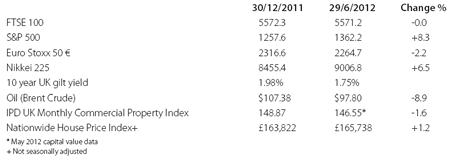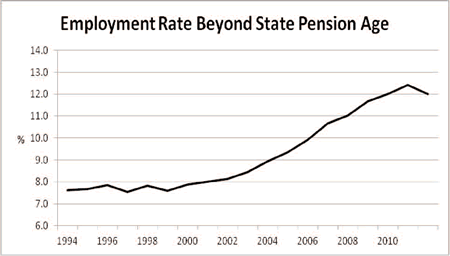


Six months busily going nowhere.
How was the first half of 2012 for investors?
The month of June ended with yet another emergency Eurozone summit – the 20th by some counts – and yet another sharp rally on the back of the latest summit’s euro-fix. How long the rebound continues remains to be seen, but for those institutions drawing a line under the half year, it was a useful kicker to the closing numbers.
Even so, UK investors found themselves having spent six months going virtually nowhere: the FTSE 100 ended 29 June at 5571.2 against a starting point for the year of 5572.3. En route, the index had moved in a range of over 700 points, flirting with 6,000 in mid-March, only to drop to 5,260 at the start of June. A better reminder of the dangers of paying too much attention to short term ‘noise’ would be hard to find.
Not all investment markets were flat over the first half, as the table below shows:

Perhaps the biggest surprise here is that the Eurozone stock markets, as measured by the Euro Stoxx 50 index of the largest companies, have fallen only marginally. Admittedly, the index’s performance was helped by a 5% jump on 29 June, but the six-month performance again underlines the ‘noise’ of daily lurches from crisis, to solution, and back to crisis.
The value of your investment can go down as well as up and you may not get back the full amount you invested. Past performance is not a reliable indicator of future performance. Investing in shares should be regarded as a long-term investment and should fit in with your overall attitude to risk and financial circumstances.
Would you accept a return under 2% a year for a decade?
Gilt yields remain near to historic lows.
The return on offer from ten-year UK government bonds was 1.75% at the end of June. The start ofthe month had seen it fall as low as 1.54% – half the current rate of RPI inflation. Where gilt yields and other long-term interest rates go from here is the subject of much debate.
Some experts believe that rates will stay low and could fall further. They argue that the UK’s ‘safe haven’ status, the need to support a very weak economy and the experience of Japan all point to continued low rates.
Other experts take a different view, warning that rates could rise sharply. They base their view on the fact that the Bank of England’s quantitative easing is distorting the gilt market – the Bank owns 36% of all conventional gilts – and will eventually have to end, heralding a return to interest rate normality.
Unfortunately the experts have had a hard time in the past few years forecasting future gilt yields. In January 2010, Bill Gross, who runs the biggest bond fund in the world, said that gilts were ‘resting on a bed of nitro glycerine’. Back then, ten-year gilt yields were around 4%....
The value of your investment can go down as well as up and you may not get back the full amount you invested. Past performance is not a reliable indicator of future performance.
Lie BOR
More revelations to emerge?
The row about the attempted rigging of LIBOR (London Interbank Offered Rate) that broke out at the end of last month probably has a long way to run. There has already been a discovery of similar banking ‘creativity’ in Japan involving TIBOR, the Tokyo equivalent, by two major investment banks, Citigroup and UBS. The Financial Services Authority (FSA) says that it ‘continues to pursue a number of other significant cross-border investigations in this area’. Press reports suggest that there are around 20 major banks under investigation. Barclays has grabbed the headlines so far because it co-operated with the authorities from an early stage, winning itself a 30% discount on the FSA penalty.
One point that has eluded much of the coverage is that, although the news currently focuses on a UK bank and LIBOR, sterling interest rates were not involved. LIBOR is not just one interest rate, but a matrix of 150 rates, covering ten major currencies and 15 time periods, from overnight to 12 months. The FSA says Barclays’ misconduct related to the setting of US dollar LIBOR and EURIBOR, which is the euro-only European Banking Federation equivalent of LIBOR. So those stories about mortgages and other loans in the UK being mispriced appear wide of the mark … at least for now.
When were you planning to retire?
About one in eight people are working beyond state pension age (SPA).
National Statistics produces annual data on the number of people who are working beyond SPA. The latest set has just been published, revealing that in the final quarter of 2011 there were over 1.4 million people working past the point at which they could draw their state pension – 12% of the pensioner population. The proportion was down from the previous year, breaking a trend of regular increases since 1998, as the graph below shows:

The decline in post-SPA employment is not quite what it seems, because the 2011 data allows for the fact that women’s SPA is on the rise (it is currently about 61 years 8 months), thereby reducing the population of post-SPA women. Before April 2010, women’s SPA was 60. Unsurprisingly, women outnumber men by about 3:2 in terms of post-SPA employment. However, whereas two thirds of the pension men were
working in ‘highly skilled’ jobs, nearly the same proportion of women is in ‘lower skilled’ employment, their most common job being cleaner.
National Statistics’ data do not show the reasons for working beyond SPA, but the need for cash to supplement pension income is probably a strong motivator. Why else would there be all those 60+ women cleaners?
Tax avoidance grabs the headlines
The media has been shining the spotlight on tax avoidance.
In June, The Times ran a series of front page exposes of tax avoidance schemes. The furore eventually saw the Prime Minister naming and shaming Jimmy Carr as ‘morally wrong’ for using a complex Jersey-based ‘K2’ scheme to shield his earnings from income tax.
The rest of the media quickly joined The Times’ bandwagon, helped by a first-tier tax tribunal decision against a film partnership scheme that involved the likes of Sir Alex Fergusson and Sven-Göran Eriksson. Somewhat inevitably this anti-tax avoidance frenzy missed a few important points:
a) The current Government has already acted against ‘disguised remuneration’, which some experts think put an end to the K2-type of scheme, or at least makes it very much more difficult to operate.
b) The football managers’ film partnership scheme was set up in 2006 and legislation since then has markedly reduced the scope for the film-related tax relief payments to individuals.
c) The Government has just started a formal consultation on a General Anti-Abuse Rule (GAAR), to be introduced in 2013. This would be used to target ‘aggressive’ tax avoidance arrangements.
d)The media coverage has very much been on the extreme end of tax avoidance; normal planning, such as using ISAs or making use of independent taxation, is not at issue.
The value of tax reliefs depends on your individual circumstances. Tax laws can change. The Financial Services Authority does not regulate tax advice.
